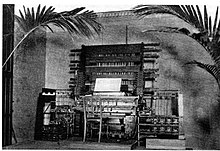This article needs additional citations for verification. (September 2011) |
Thaddeus Cahill | |
|---|---|
 | |
| Born | Thaddeus Cahill June 18, 1867 |
| Died | April 12, 1934 (aged 66) |
| Occupation | Inventor |
Thaddeus Cahill (June 18, 1867 – April 12, 1934) was a prominent inventor of the early 20th century. He is widely credited with the invention of the first electromechanical musical instrument, which he dubbed the telharmonium.
He studied the physics of music at Oberlin Conservatory in Oberlin, Ohio. After working as a clerk for Congress in Washington D.C. to pay for his college studies, he graduated from the Columbian (now George Washington University) Law School in 1889. He became convinced that music could be made with electricity (and also worked on an electric typewriter). He showed his first teleharmonium to Lord Kelvin in 1902. That year he established a laboratory at Holyoke, where he was joined by his brother, Arthur T. Cahill, and where the two would first demonstrate the teleharmonium to a public audience.[1][2]

Cahill had tremendous ambitions for his invention; he wanted telharmonium music to be broadcast into hotels, restaurants, theaters, and even houses via the telephone line.[3] At a starting weight of 7 tons (and up to 200 tons) and a price tag of $200,000 (approx. $5,514,000 today), only three telharmoniums were ever built, and Cahill's vision was never fully implemented.
- ^ "Electrical World (McGraw-Hill)". 47 (13). 1906: 656. Retrieved 26 September 2011.
{{cite journal}}: Cite journal requires|journal=(help) - ^ Dewan, Brian (Winter 2002). "Thaddeus Cahill's 'Music Plant'". Cabinet Magazine. Archived from the original on March 1, 2021.
Cahill patented the Telharmonium in 1897 and in 1902 he and his two business partners founded the New England Electric Music Company. The Telharmonium was first publicly demonstrated in Holyoke, Massachusetts, in 1906, and later that year he had it moved to New York City. It weighed 200 tons and required 30 boxcars to ship.
- ^ Holmes, Thomas B.; Thom Holmes (2002). Electronic and experimental music: pioneers in technology and composition. Psychology Press. pp. 42–49. ISBN 0-415-93644-6.